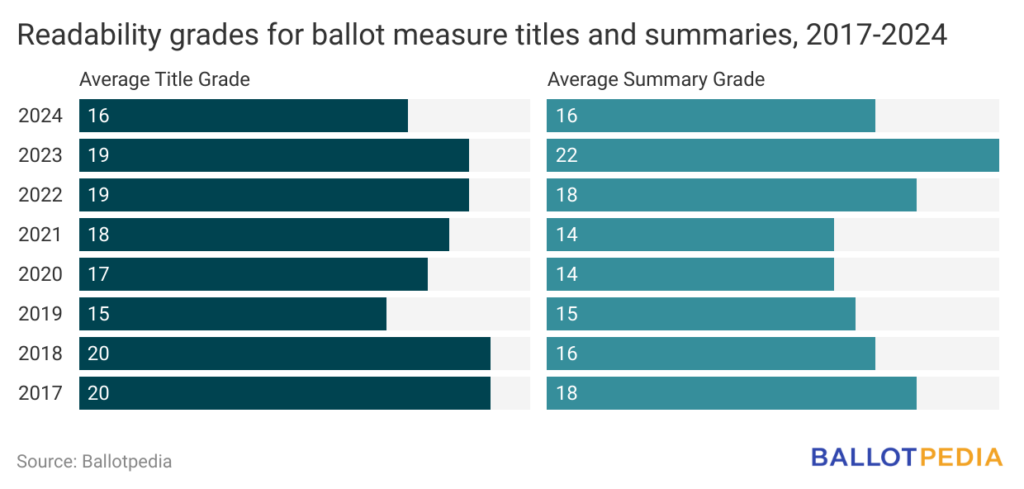The language for the 159 statewide ballot measures in 41 states in 2024 is written at an average reading level of 16, equivalent to a bachelor's degree. This is a decrease from the average reading level of 19 in 2023 and 2022. Sixty-nine (69) of the ballot measures included additional information, known as a ballot summary, and those also had an average score of 16.
Ballotpedia's readability report offers insights into the educational level voters might need to comprehend statewide ballot measure titles and summaries.
Using the Flesch-Kincaid Grade Level (FKGL) and Flesch Reading Ease (FRE), the report measures how accessible these texts are based on objective factors, such as the number of syllables, words, and sentences in a text. It's important to note that these scores focus solely on language structure, not the complexity of the ideas themselves.
Below are some highlights from the annual report, which is available here.
Since 2017, Ballotpedia has tracked the readability scores of statewide ballot measures. The following table shows the average ballot title grade, word counts, summary grade, and the number of measures for each year. The year with the lowest ballot title grade was 2019, with 15, and the years with the highest were 2017 and 2020, with 20.

In 2024, the state with the lowest average grade level score for a ballot title was New Hampshire, with a score of seven. The highest average was Alabama, with a score of 28. The average number of words in a ballot title was 68, ranging from seven words in Florida to 940 in Ohio.
The difference in average grade levels between types of ballot measures—whether citizen-initiated or legislative, constitutional or statutory—was no more than two years. The average title score for ballot initiatives was 15, ranging from a score of eight for Washington Initiative 2124 to 32 for Colorado Amendment 79. The average title score for referred ballot measures, such as those from legislators, was 17, ranging from a score of -2 for Florida Amendment 2 to 42 for Maine Question 2.
Measures cover various topics, and patterns or trends emerge across the states. In 2024, trends include abortion, ranked-choice voting, and citizenship, among other topics. Of the identified ballot measure trends, abortion-related ballot measures had the highest grade level scores for their titles, averaging 17, while wage-related policies had the lowest, averaging 11.

Since ballot measures often consist of multiple pages of legal text, each state assigns a person or group to write a shorter title for voters to read on the ballot. Those who write the ballot titles include attorneys general, secretaries of state, lieutenant governors, state boards, state legislatures, or the initiative proponents themselves. While lieutenant governors wrote ballot titles for just four measures—two in Alaska, and two in Utah—these had the lowest scores at nine. Boards wrote the ballot language for nine measures, and these had the highest average scores at 20. Legislatures wrote the most ballot titles, 59, which had an average score of 18.
The following individual ballot measures had the highest or lowest grade level scores or word counts:
- The ballot measure with the highest ballot title grade level, at 42, was Maine Question 3, a bond measure to issue $25 million in general obligation bonds for the Maine Technology Institute. While no formal education level, including post-graduate, corresponds to a 42nd-grade level, this indicates that the language structure is advanced or difficult, at least based on the FKGL
- The ballot measure with the lowest ballot title grade level, at -2, was Florida Amendment 2, an amendment to provide a state constitutional right to hunt and fish. While no formal education level corresponds to -2 years, this number indicates that the language structure is basic, corresponding to two years below 1st grade. The exact ballot title is short and uses one-syllable words: "Right to Fish and Hunt." This was the lowest score for a ballot measure title, and the first below zero, since Ballotpedia started tracking scores in 2017.
- The longest ballot title, with 940 words, was for Ohio Issue 1, an initiative to establish a non-politician redistricting commission. The next longest title, for North Dakota Initiated Measure 1, had 303 words. Ohio Issue 1 had the longest ballot title since Ballotpedia started tracking scores in 2017. Before Ohio Issue 1, the longest ballot title was for Arkansas Issue 4 of 2018, which had 710 words.
- The shortest ballot titles each had five words. There are three measures with five-word ballot titles: California Proposition 32, Florida Amendment 2, and Florida Amendment 3.
In 2024, one state—Rhode Island—passed legislation requiring that ballot questions be written in plain language and so that someone with an eighth-grade reading level can understand them. The bill received unanimous approval in the state legislature. For 2017 to 2023, the average FKGL score for Rhode Island was 11, ranging from nine in 2018 to 12 in 2021 and 2022. In 2024, the FKGL score increased to 14. You can read more about readability laws here.


